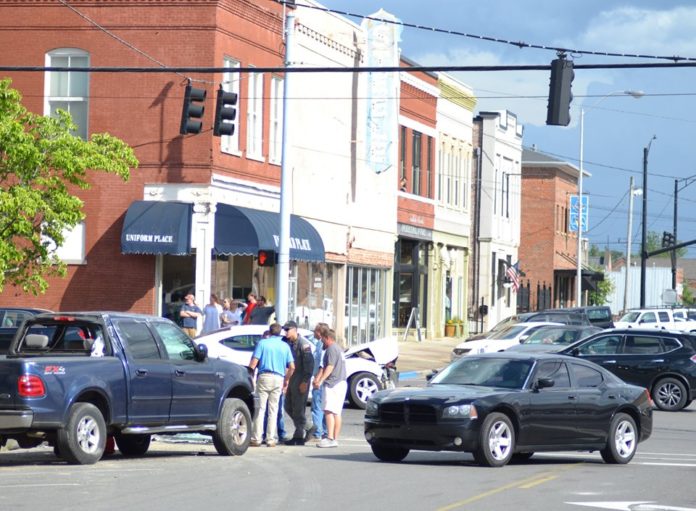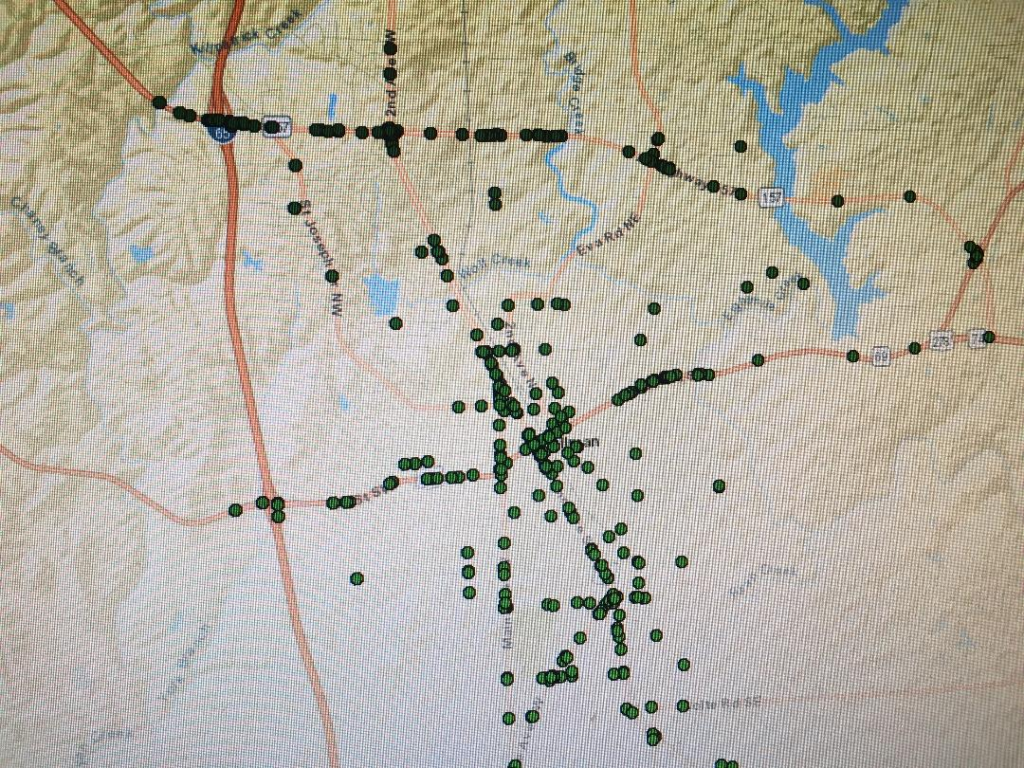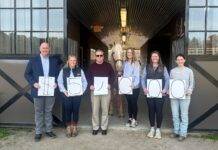
CULLMAN, Ala. – In the last couple of years, the Cullman Police Department (CPD) has been dealing with a rash of vehicle wrecks across the city of Cullman like it has not seen before: 618 crashes to this point in the year, on pace for a total of 967 for 2019. Last year’s total was even higher at 1,006. Just a few years ago in 2012, CPD worked a total of only 250.
Traffic Homicide Investigator Sgt. Joey Duncan said, “We work more wrecks than towns that are like double our size. I mean, it’s crazy how many wrecks we’re having, but the good news is, is all these extra efforts we’re doing with public awareness, especially on weekends, we get (Traffic Homicide Investigator Officer Jonathan England) and we attack the high crash areas, and we go after what’s causing the wrecks. We’ve only had two fatalities this year, and that’s huge.”
The CPD is certainly glad that deaths are down and that it can report that most wrecks are minor incidents, but at 618 so far this year, officers still consider the number way too high.
Where are the wrecks?
A digital map plotting the GPS coordinates of each crash this year, along with the recollections of England and Duncan, pinpointed the most common crash sites around the city:
- Intersection of U.S. Highway 31 and Alabama Highway 157
- Intersection of Alabama Highway 69 and Alabama Highway 157
- Intersection of U.S. Highway 278 and U.S. Highway 31
- Intersection of Cherokee Avenue and 24th Street Southwest
- Intersection of Cherokee Avenue and Patriot Way
- Intersection of Main Avenue Southwest and Graham Street Southwest
- Interstate 65 Exit 310 (Highway 157)
Certain roads see high numbers of crashes all along their length through the city, including:
- Highway 157, with concentrations at intersections with I-65, Highway 31, Childhaven Road and Eva Road
- Highway 31, with strong concentrations through downtown Cullman, at the Highway 157 intersection to the north, and at the Cherokee Avenue intersection to the south
- Highway 278, with concentrations in the heart of downtown, on the west side near West Elementary School and Johnny’s Bar-B-Q, and to the east around the Lowery’s Station area
- Main Avenue Southwest/Northwest, with the strongest concentration between Highway 278 and Highway 31
According to England, the busiest times for wrecks tend to be between 11 a.m. and 5 p.m., though there are exceptions. Crashes tend to occur at the 157/69 intersection, for instance, more often during the morning rush. Weekends seem to see fewer wrecks, on average.
Why are the wrecks happening?
Duncan and England identified the two most common causes for crashes as vehicles following other vehicles too closely, especially when drivers are distracted, and vehicles running red lights.
Said Duncan, “Speed intensifies injury; we know that. It’ll cause a worse injury, obviously. But the number one cause of a crash, by far, is following too close. It’s like percentage- we’re almost at 70% of our wrecks. It’s that bad, because people are not paying attention; they’re doing something so they don’t have enough distance to stop before colliding with the other vehicle, you know, and it’s bad.”
A wreck at the 157/69 intersection, investigated during The Tribune’s ride-along with the CPD Wednesday night, Aug. 21, appeared to have occurred when a driver stopped behind another driver in the turn lane from 69 onto 157, looked left until the traffic was clear, and accelerated without noticing that the car in front was still stopped.
At certain intersections, inattention to traffic lights creates danger. According to Duncan, 90% of wrecks at the Highway 157/Highway 69 intersection are due to drivers running the red light.
What should drivers do?
The formula for avoiding the most common collisions in Cullman seems fairly simple:
- Keep a safe distance between your vehicle and those ahead of you.
- Pay close attention to everything around you, especially in traffic.
- Do not run red lights.
- Remember that, as careful as you might be to avoid causing an accident, you want to be just as careful to avoid becoming a victim. If you avoid running a red light, someone else might not.
Said England, “When the light is green, pay attention: look both ways, make sure that nobody’s coming through the intersection. Never rely on somebody else.”
Avoid distractions: turn off electronic devices
The CPD’s observations of drivers not paying attention to what they are doing or to what is happening around them echo growing concerns about distracted driving across the nation, with electronic devices being cited as one of the biggest culprits. Almost everyone has seen ads, commercials or online videos about the dangers of driving while texting, reading or even talking on a hand-held cell phone. The National Safety Council (NSC) has published studies, though, indicating that even the new generation of hands-free technology does not help nearly as much as people think.
In its 2012 publication Understanding the Distracted Brain, the NSC stated:
Multitasking is valued in today’s culture, and our drive for increased productivity makes it tempting to use cell phones while behind the wheel. People often think they are effectively accomplishing two tasks at the same time. And yes, they may complete a phone conversation while they drive and arrive at their destination without incident, thus accomplishing two tasks during the same time frame. However, there are two truths to this common belief.
- People actually did not “multitask.”
- People did not accomplish both tasks with optimal focus and effectiveness.
Multitasking is a myth. Human brains do not perform two tasks at the same time. Instead, the brain handles tasks sequentially, switching between one task and another. Brains can juggle tasks very rapidly, which leads us to erroneously believe we are doing two tasks at the same time. In reality, the brain is switching attention between tasks – performing only one task at a time.
The study focused on cell phone use, which the NSC considers to be among the biggest safety issues for drivers, including those who use hands-free technology. The report continued:
Vision is the most important sense for safe driving. Yet, drivers using hands-free phones (and those using handheld phones) have a tendency to “look at” but not “see” objects. Estimates indicate that drivers using cell phones look but fail to see up to 50 percent of the information in their driving environment. Distracted drivers experience what researchers call inattention blindness, similar to that of tunnel vision. Drivers are looking out the windshield, but they do not process everything in the roadway environment that they must know to effectively monitor their surroundings, seek and identify potential hazards, and respond to unexpected situations.
Today there are more than 320 million wireless connections in the U.S. And although public sentiment appears to be turning against cell phone use while driving, many admit they regularly talk or text while driving. The National Highway Traffic Safety Administration estimates that nine percent of all drivers at any given time are using cell phones, and the National Safety Council estimates about one in four motor vehicle crashes involve cell phone use at the time of the crash.
Cell phone distracted driving has become a serious public health threat. A few states have passed legislation making it illegal to use a handheld cell phone while driving. These laws give the false impression that using a hands-free phone is safe.
The NSC’s study indicated that drivers carrying on cell phone conversations, even hands-free, tended to suffer:
- Inattention blindness – not seeing things right in front of them, and especially to the sides. Eye movement studies showed that drivers talking on hands-free phones tended to focus their eyes on a much smaller field right in front of their vehicles and not keep an active watch on other areas within their field of vision. Areas outside the talking drivers’ narrow focus include common locations of STOP signs, traffic lights, oncoming side road traffic at intersections, and points from which pedestrians are likely to step out into the street.
- Slower response time and reaction time – In one driving simulator study, participants actively engaged in cell phone conversations had slower reaction and response times than participants with a .08 blood alcohol concentration, legally drunk in Alabama.
- Problems staying in their lanes
The NSC study concluded that a person talking on a cell phone while driving is four times more likely to be involved in a crash than a person not using a phone, whether the device is hand-held or hands-free.
CPD Traffic Homicide Investigation
In 2017, the CPD sent Duncan and England for specialized training in traffic homicide investigation, in order to lay the foundation for a specialized and dedicated Traffic Homicide Unit. In wrecks involving a fatality, the investigators can work up a 300-page package of incident details as specific as the depth of tread on the tires of involved vehicles. In less than two years, their new skill set has produced five indictments for vehicular homicide.
Said Duncan, “The (Cullman County) DA’s office loves it. I mean, they’re getting everything they need for prosecution.”
The Tribune will return to ride with CPD traffic officers next week, for a look at specific actions the department is taking to combat the crash problem and an inside view of how officers reduced accidents on one of the city’s “bad” roads last year to a small handful of incidents this year.
Copyright 2019 Humble Roots, LLC. All Rights Reserved.

Dots on a Cullman Police Department digital map indicate 2019 wrecks around the city of Cullman. Map created Aug. 21, 2019.































